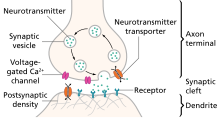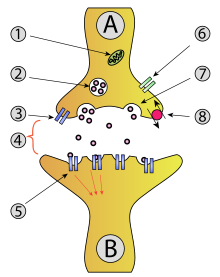 | This is a user sandbox of Jenelove. You can use it for testing or practicing edits. This is not the sandbox where you should draft your assigned article for a dashboard.wikiedu.org course. To find the right sandbox for your assignment, visit your Dashboard course page and follow the Sandbox Draft link for your assigned article in the My Articles section. |


N-type calcium channels are voltage gated calcium channels that are distributed throughout the entire body. These channels are high voltage activated channels that are composed of alpha-1B subunits. The alpha subunit forms the pore through which the calcium enters and determines most of the channel properties. The alpha subunit is also known as the calcium channel, voltage dependent, N type, alpha 1 subunit (CANCA1B), or Cav2.29(which is used in therapeutic processes), which is humans encoded by the CANCA1B gene.[1] They also contain associated subunits such as B1, B3, B4, α2δ, and possibly Y.These channels are known for their importance in the nervous system. They have a role in the migration of immature neurons before the establishment of their synaptic neuron, and they are critically involved in the release of neurotransmitters, which is also similar to the P-type channels. N-type calcium channels are also targets for the development of drugs to relieve chronic and neuropathic pain. They are also used for the treatment of Hypertension, Autism Spectrum Disorder, Osteoarthritis, and other medical diagnosis.N-type calcium channels function differently in the development of the hippocampal neurons by being that they don’t contribute until the later developmental stages of the hippocampal.These channels also have functions within the Kidney and the Heart. There are many N-type calcium channel blockers, but the main blocker is w-Conotoxins. These blockers can interfere with many therapeutic processes.[2]
Structure edit
In addition to the α1 subunit, the following subunits are present in the N-type calcium channel:
Function edit
N-type calcium channels are highly known for their function in the nervous system, but they are also involved with the function of the heart and kidneys. They are also important in neurotransmitter release because they are localized at the synaptic terminals.[3] When the calcium flows into a single N-type calcium channel due to an action potential, it is necessary to trigger the fusion of the secretory vesicle. Research has shown that in the heart, when the N-type calcium channel blocker ω-Conotoxin is introduced causes there to be no more release of norepinephrine. This shows that only the N-type calcium channel, and not the L/P/Q type channels are involved in the release of norepinephrine.[4] In the Kidneys, N-type calcium channels reduces glomerular pressure through dilation of arterioles when the channel is blocked.[5]The inhibition of this channel by Calcium channel blockers can lead to renal microcirculation. N-type calcium channels have been shown to play a part in the localization of neurite growth in the sympathetic nervous system and the skin and spinal cord. The neurite outgrowth was shown to be inhibited through an interaction between laminin and the 11th loop of the n-type calcium channel structure.[6] It has been suggested that neuritis outgrowth is inhibited by the influx of calcium through the growth cone, and this happens when the Cav2.2 subunit comes in contact with laminin 2 and in response can induce a stretch activation of the N-type calcium channel.[7]
Blockers edit
- ω-Conotoxins
- Ziconotide
- Caroverine
- Cilnidipine
- NP078585
- TROX-1
- Cadmium
- Gabapentin
- Levetiracetam
- Lamotrigine
- Nicardipine
Clinical significance edit
N-type calcium channels have been connected to a variety of different clinical diagnoses. They are most commonly linked to therapeutic treatment of chronic pain. Studies have shown that the intrathecal injection of calcium channel inhibitors such as Ziconotide to block the N-type calcium channels have produced alleviation of intractable pain.[8] The use of blockers to inhibit the N-type calcium channels have produced alleviation of chronic pain from a variety of different diseases. For example blockade of the N-type calcium channel is a potential therapeutic strategy for the treatment of alcoholism.[9] Studies have also shown that N-type peptide blockers have been used to relieve pain that results from osteoarthritis, hypertension, diabetic neuropathy,[10] and cancer.[11] The use of intrathecally injected N-type channel blockers has shown to be more beneficial than common opioid remedies since there are less negative side effects associated. The alteration of N-type calcium channels in therapeutic processes occurs in four major ways; through the blockage of N-type calcium channel peptides, interference of the flow of ions through the channel itself, activation of G-protein coupled signaling, and interference of the G-protein pathways.[12] N-type calcium channels have also been associated with several diseases as well. For example mutations in CACNA1B are associated to Myoclonus-Dystonia syndrome .[13] Duplication of the CACNA1B gene has also been linked to cases of the Autism Spectrum Disorder.[14]
References edit
- ^ Williams, Mark; Brust, Paul; Feldman, Daniel; Patthi, Saraswathi; Simerson, Susan; Maroufi, Azarnoush. "Structure and functional expression of an omega-conotoxin-sensitive human N-type calcium channel". Science. 257 (5068).
- ^ Adams, David. "Mechanisms of conotoxin inhibition of N-type (Cav2.2) calcium channels". Elsevier. 1828 (7): 1619–1628. Retrieved 10 April 2017.
- ^ "Single N-Type Calcium Channel May enable Neurotransmitter release". NeuroScience. Plus Biology.
- ^ Molderings GJ, Likungu J, Göthert M (February 2000). "N-Type calcium channels control sympathetic neurotransmission in human heart atrium". Circulation. 101 (4): 403–7. PMID 10653832.
- ^ Hayashi K, Wakino S, Sugano N, Ozawa Y, Homma K, Saruta T (February 2007). "Ca2+ channel subtypes and pharmacology in the kidney". Circulation Research. 100 (3): 342–53. doi:10.1161/01.RES.0000256155.31133.49. PMID 17307972.
- ^ Weiss N (May 2008). "The N-type voltage-gated calcium channel: when a neuron reads a map" (PDF). The Journal of Neuroscience. 28 (22): 5621–2. doi:10.1523/JNEUROSCI.1538-08.2008. PMID 18509022.
- ^ Weiss, Norbert. "The N-Type Voltage-Gated Calcium Channel: When a Neuron Reads a Map" (PDF). The Journal of Neuroscience.
- ^ Dray A, Read SJ (May 2007). "Arthritis and pain. Future targets to control osteoarthritis pain". Arthritis Research & Therapy. 9 (3): 212. doi:10.1186/ar2178. PMC 2206352. PMID 17561993.
{{cite journal}}: CS1 maint: unflagged free DOI (link) - ^ Newton PM, Zeng L, Wang V, Connolly J, Wallace MJ, Kim C, Shin HS, Belardetti F, Snutch TP, Messing RO (November 2008). "A blocker of N- and T-type voltage-gated calcium channels attenuates ethanol-induced intoxication, place preference, self-administration, and reinstatement". The Journal of Neuroscience. 28 (45): 11712–9. doi:10.1523/JNEUROSCI.3621-08.2008. PMID 18987207.
- ^ Javed S, Petropoulos IN, Alam U, Malik RA (January 2015). "Treatment of painful diabetic neuropathy". Therapeutic Advances in Chronic Disease. 6 (1): 15–28. doi:10.1177/2040622314552071. PMID 25553239.
- ^ Bruel BM, Burton AW (December 2016). "Intrathecal Therapy for Cancer-Related Pain". Pain Medicine. 17 (12): 2404–2421. doi:10.1093/pm/pnw060. PMID 28025375.
- ^ Zamponi GW, Striessnig J, Koschak A, Dolphin AC (October 2015). "The Physiology, Pathology, and Pharmacology of Voltage-Gated Calcium Channels and Their Future Therapeutic Potential". Pharmacological Reviews. 67 (4): 821–70. doi:10.1124/pr.114.009654. PMID 26362469.
- ^ Groen JL, Andrade A, Ritz K, Jalalzadeh H, Haagmans M, Bradley TE, Jongejan A, Verbeek DS, Nürnberg P, Denome S, Hennekam RC, Lipscombe D, Baas F, Tijssen MA (February 2015). "CACNA1B mutation is linked to unique myoclonus-dystonia syndrome". Human Molecular Genetics. 24 (4): 987–93. doi:10.1093/hmg/ddu513. PMID 25296916.
- ^ Heyes S, Pratt WS, Rees E, Dahimene S, Ferron L, Owen MJ, Dolphin AC (November 2015). "Genetic disruption of voltage-gated calcium channels in psychiatric and neurological disorders". Progress in Neurobiology. 134: 36–54. doi:10.1016/j.pneurobio.2015.09.002. PMC 4658333. PMID 26386135.
Further reading edit
- Calabrese B, Tabarean IV, Juranka P, Morris CE (November 2002). "Mechanosensitivity of N-type calcium channel currents". Biophysical Journal. 83 (5): 2560–74. Bibcode:2002BpJ....83.2560C. doi:10.1016/S0006-3495(02)75267-3. PMC 1302342. PMID 12414690.
- Moskvina V, Craddock N, Holmans P, Nikolov I, Pahwa JS, Green E, Owen MJ, O'Donovan MC (March 2009). "Gene-wide analyses of genome-wide association data sets: evidence for multiple common risk alleles for schizophrenia and bipolar disorder and for overlap in genetic risk". Molecular Psychiatry. 14 (3): 252–60. doi:10.1038/mp.2008.133. PMID 19065143.
- Castiglioni AJ, Raingo J, Lipscombe D (October 2006). "Alternative splicing in the C-terminus of CaV2.2 controls expression and gating of N-type calcium channels". The Journal of Physiology. 576 (Pt 1): 119–34. doi:10.1113/jphysiol.2006.115030. PMC 1995641. PMID 16857708.
- Catterall WA, Perez-Reyes E, Snutch TP, Striessnig J (December 2005). "International Union of Pharmacology. XLVIII. Nomenclature and structure-function relationships of voltage-gated calcium channels". Pharmacological Reviews. 57 (4): 411–25. doi:10.1124/pr.57.4.5. PMID 16382099.
- Olsen JV, Blagoev B, Gnad F, Macek B, Kumar C, Mortensen P, Mann M (November 2006). "Global, in vivo, and site-specific phosphorylation dynamics in signaling networks". Cell. 127 (3): 635–48. doi:10.1016/j.cell.2006.09.026. PMID 17081983.
- Stotz SC, Barr W, McRory JE, Chen L, Jarvis SE, Zamponi GW (January 2004). "Several structural domains contribute to the regulation of N-type calcium channel inactivation by the beta 3 subunit". The Journal of Biological Chemistry. 279 (5): 3793–800. doi:10.1074/jbc.M308991200. PMID 14602720.
{{cite journal}}: CS1 maint: unflagged free DOI (link) - Maximov A, Bezprozvanny I (August 2002). "Synaptic targeting of N-type calcium channels in hippocampal neurons" (PDF). The Journal of Neuroscience. 22 (16): 6939–52. PMC 3307533. PMID 12177192.
- Peng S, Hajela RK, Atchison WD (December 2002). "Characteristics of block by Pb2+ of function of human neuronal L-, N-, and R-type Ca2+ channels transiently expressed in human embryonic kidney 293 cells". Molecular Pharmacology. 62 (6): 1418–30. doi:10.1124/mol.62.6.1418. PMID 12435810.
- Murakami M, Fleischmann B, De Felipe C, Freichel M, Trost C, Ludwig A, Wissenbach U, Schwegler H, Hofmann F, Hescheler J, Flockerzi V, Cavalié A (October 2002). "Pain perception in mice lacking the beta3 subunit of voltage-activated calcium channels". The Journal of Biological Chemistry. 277 (43): 40342–51. doi:10.1074/jbc.M203425200. PMID 12161429.
{{cite journal}}: CS1 maint: unflagged free DOI (link) - Vitko I, Shcheglovitov A, Baumgart JP, Arias-Olguín II, Murbartián J, Arias JM, Perez-Reyes E (2008). Schwartz A (ed.). "Orientation of the calcium channel beta relative to the alpha(1)2.2 subunit is critical for its regulation of channel activity". PloS One. 3 (10): e3560. Bibcode:2008PLoSO...3.3560V. doi:10.1371/journal.pone.0003560. PMC 2570331. PMID 18958281.
{{cite journal}}: CS1 maint: unflagged free DOI (link) - Agler HL, Evans J, Tay LH, Anderson MJ, Colecraft HM, Yue DT (June 2005). "G protein-gated inhibitory module of N-type (ca(v)2.2) ca2+ channels". Neuron. 46 (6): 891–904. doi:10.1016/j.neuron.2005.05.011. PMID 15953418.